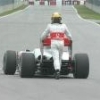I see the V6 turbos still being around, but repurposed as range extenders for the 2 electric motors that will propel the car.

Post V6T - What's next
#51

Posted 24 February 2014 - 20:56
Advertisement
#52

Posted 24 February 2014 - 20:59
but you forgot this
That should solve the carbon footprint issue as well as obesity epidemics. Two birds one stone.
#53

Posted 24 February 2014 - 21:15
Energy limits with whatever architecture between 2 or 3 pre-designed options.
#54

Posted 24 February 2014 - 22:00
On a serious note, this is a very good thread with a good question to ponder upon. Majority of the electricity produced in the world is through non-renewable sources. A lot of it is going nuclear, and while most are chuffed about reduced carbon footprint, they conveniently forget that everything is at a cost. Waste disposal is a big hassle with nuclear energy with half life of some elements going into millions of years. Hydrogen is the first element of the periodic table. Well, being the lightest element it has certain properties, which make storage of it rather difficult, and further complicated by the flammability of it. Fuel cell is perhaps the way forward, produce Hydrogen on demand and clean burning. However, the technical difficulties of it for implementation in a motorsport. Well, i'm sure engineers have already gone over it. Does anyone have a good reference?
#55

Posted 24 February 2014 - 22:18
most hydrogen production is energy negative sadly
#56

Posted 24 February 2014 - 22:25
It is all negative. The focus should be on how to reduce overall impact on the environment when looking at alternative fuel sources for the sport, and so far, that would be perhaps the least harmful way?
On the other hand, seems you're quite versed with the problem at hand, would you share your views? Do forgive, if i do not remember reading them on the first page. It is just a little crazy at my end(the usual ![]() ).
).
most hydrogen production is energy negative sadly
________________________________
edit: on the other hand, F1 has limited packaging opportunities. Electricity is a tricky little so and so and it is only a matter of time before something goes horribly wrong. They should concentrate on evolving packaging to allow more space (could have an effect of either slowing/ speeding cars), in a way to do it more safely. The other day we witnessed a driver performing a jack rabbit jump. Seriously, we have to make it safer, or fall back to liquid fuels proper till some workaround comes to fruition.
Edited by garagetinkerer, 24 February 2014 - 22:30.
#57

Posted 24 February 2014 - 23:35
I think Hamsters might feature in the future of F1 propulsion.
#58

Posted 25 February 2014 - 00:25
I don't believe the next engine iteration will be full electric. Unless the battery technology really advances in the next 10 years or so, I think we will still be looking at hybrids with ever more powerful ERS systems on board. I will certainly be quite interested to know what they will come up with.
Graphene - http://news.bbc.co.u...ine/9491789.stm
Read through the article and its easy to see why its "the next big thing etc".
Hasn't it been the next big thing for about a decade now ![]()
Maybe in the future people can accept the fact that it's actually OK for road car industry and the 'racing industry' to have different ends...
With the former being about safety, sustainability/efficiency through technology etc., and the later reflecting the more superfluous - sport, art, spectacle
Being the 'pinnacle' of motorsport can simply be about having the lowest weight, highest powered machinery...
Which you can achieve using modern engines, rather than arbitrarily deciding to stop and stagnate at the V10s. We can achieve Colin Chapman's philosophy of ever lighter cars with greater fuel efficiency. The less fuel the cars need the less weight they have to carry, which brings the added benefit of better handling at the beginning of the races. If you wish the engines to start producing more power, we can achieve that by utilising energy recovery systems, and allowing them to reclaim more energy. There is no reason why we have to stick with the old methods of increasing displacement or making them rev even higher when technology is advancing.
#59

Posted 25 February 2014 - 01:05
its negative energy because you use more energy making hydrogen than you can get out of what you produce. But you can use conventional like delivery like we do for cars, aka petrol hydrogen stations.
imo if we could mass produce cheap effiecent solar panels and green energy stuff, and it got put on every roof and wall, and that was basis for energy generation, with power plants doing filling in and topping up, then that might be a way forward
Edited by pingu666, 25 February 2014 - 01:11.
#61

Posted 25 February 2014 - 03:09
I think the next big step would be to have the energy recovery taking a much bigger role, so that the petrol engine supplements the ERS rather than the vice versa we have now.
Step after that would be electric, with heavy use of energy recovery
#62

Posted 25 February 2014 - 05:12
I think the next big step would be to have the energy recovery taking a much bigger role, so that the petrol engine supplements the ERS rather than the vice versa we have now.
Step after that would be electric, with heavy use of energy recovery
In that case, I believe a smallish turbine being ideal really. Indeed, it would not drive the wheels at all, but act as an input to a generator. This generator would top up the energy store and fill in the deficit to the ERS.
One problem though: will the manufacturers buy into this idea? If it's not relevant to them, they won't (regardless of anyone's opinions of the rights and wrongs of them holding that power).
#63

Posted 25 February 2014 - 05:36
I think Hamsters might feature in the future of F1 propulsion.
I was about to mock up a picture of a car with 4 wheels and hamsters, one in each ![]()
To my surprise, ulp:


 yes, this is a drag race!
yes, this is a drag race!
![]()
You live, you learn! effin' brilliant!
Edited by garagetinkerer, 25 February 2014 - 05:38.
#64

Posted 25 February 2014 - 06:44
Its my birthday in 3 weeks ... if anyone is stuck for a gift idea ![]()
#65

Posted 25 February 2014 - 13:05
most hydrogen production is energy negative sadly
At this time. That's just a technology issue that a great number of people are working on and one I'm confident will be solved.
#66

Posted 25 February 2014 - 13:28
Hydrogen produced by inverted fuel cells powered by wind mills? Hugely inefficient, I know, but over time could be energy positive?
#67

Posted 25 February 2014 - 13:51
Surely it's an economic issue as much as an energy balance issue. The point is that vehicles need an energy store (fuel) that they can carry with them to be autonomous. If we have a clean but energy intensive means of producing such fuel, but it's cheap enough, then it will be a viable system.
#68

Posted 25 February 2014 - 14:02
2020 - electric cars
2025 - rubber band powered cars
2030 - wind up cars
I think the 2014 Caterham is a wind-up.
Edited by onemoresolo, 25 February 2014 - 14:20.
#69

Posted 25 February 2014 - 15:19
An absolute fact is that the hybrid technology will feature even more prominently. I'd hazard a guess and say 50MJ per lap and a 250 kW discharge rate (we went from 66kW to 120kW in 5 years, bear in mind). Perhaps constant use throughout a lap? It may sound absurd, but we're talking of 10 years down the line here - think how fast computer systems have developed in that time.
Your guess is way off the mark though.
I was interested in the theoretical upper bound of energy to be harvested so I took a Renault telemetry from Bahrain (lots of heavy breaking) and wrote down the top and low speeds for the 8 braking zones. I calculated the kinetic energy lost in each of the braking zones, and the grand total is 15 MJ per lap with a 700 kg car. This is the utmost upper bound, I should subtract the work drag does in slowing the car down but it's more effort and I can't be bothered right now.
Even if you have a nearly full efficiency ERS on all wheels (no brake discs, etc.) there's no way you could gather more than 10 MJ, which, distributed over ~60 seconds of full throttle use is about 166 kW. This is the theoretical limit of hybrid running in Bahrain.
#70

Posted 25 February 2014 - 15:52
Your guess is way off the mark though.
I was interested in the theoretical upper bound of energy to be harvested so I took a Renault telemetry from Bahrain (lots of heavy breaking) and wrote down the top and low speeds for the 8 braking zones. I calculated the kinetic energy lost in each of the braking zones, and the grand total is 15 MJ per lap with a 700 kg car. This is the utmost upper bound, I should subtract the work drag does in slowing the car down but it's more effort and I can't be bothered right now.
Even if you have a nearly full efficiency ERS on all wheels (no brake discs, etc.) there's no way you could gather more than 10 MJ, which, distributed over ~60 seconds of full throttle use is about 166 kW. This is the theoretical limit of hybrid running in Bahrain.
Did you include the mguh in your calculations?
#71

Posted 25 February 2014 - 16:23
Did you include the mguh in your calculations?
Nope, I only did kinetic energy. I see MGUH as a different deal, as it's "just" an extension of the combustion engine making it more efficient.
#72

Posted 25 February 2014 - 16:32
I read somewhere that the current V6 was Ferrari's request over an initially proposed 1.6 straight 4? A straight 4 would be the ultimate platform to build an economical and low cost road car engine and allowed the FIA to reduce the amount of homologation needed. The 1.6 I4 could be used in rallying and lower formula cars quite easily too.
With this in mind it would seem only a matter of time till the FIA get there way and go to a 4 pot.
I'd also presume that the power/weight ratio of an optimised I4 would be better than a V6 of the same displacement.
I'm so glad we got the V6 over an I4 for now though, it might not scream but it does crackle and purr whereas an I4 would be too flat and boring for F1.
#73

Posted 25 February 2014 - 17:04
Nope, I only did kinetic energy. I see MGUH as a different deal, as it's "just" an extension of the combustion engine making it more efficient.
Ok, that's your perogative, but you can't really dismiss Kilowatts guess if you've left out a major factor in the equation. The mguh will be charging the ES a lot.
#74

Posted 25 February 2014 - 18:39
Ok, that's your perogative, but you can't really dismiss Kilowatts guess if you've left out a major factor in the equation. The mguh will be charging the ES a lot.
Well from a black box perspective I don't see much difference between making your engine 2% more efficient or having a MGUH that recaptures the same amount from waste heat. At the end of the day the MGUH is a device that runs on burnt fuel. It recovers up to 2 MJ per lap currently by the way.
As I was interested in seeing how much kinetic energy is transferred via braking, I calculated that. If you want to expand it to cover other factors, feel free to add them.
#75

Posted 25 February 2014 - 18:51
1 Liter 4 cylinder
twin turbo with ERS/DRS etc...
or
2 Liter twin turbo diesel with ERS/DRS...
#76

Posted 25 February 2014 - 19:50
Your guess is way off the mark though.
Well from a black box perspective I don't see much difference between making your engine 2% more efficient or having a MGUH that recaptures the same amount from waste heat. At the end of the day the MGUH is a device that runs on burnt fuel. It recovers up to 2 MJ per lap currently by the way.
As I was interested in seeing how much kinetic energy is transferred via braking, I calculated that. If you want to expand it to cover other factors, feel free to add them.
You are free to be interested in what you like of course but it makes no sense to say Kilowatts guess is way off the mark and then talk about something completely different.
#77

Posted 25 February 2014 - 19:57
Well from a black box perspective I don't see much difference between making your engine 2% more efficient or having a MGUH that recaptures the same amount from waste heat. At the end of the day the MGUH is a device that runs on burnt fuel. It recovers up to 2 MJ per lap currently by the way.
As I was interested in seeing how much kinetic energy is transferred via braking, I calculated that. If you want to expand it to cover other factors, feel free to add them.
I guess you're probably right. I read the exchange between you and Lazy, both make good points.
Pragmatically speaking, the only reason the brakes get hot or the mgu-k gets charged is via burned fuel too, not right?
Regardless, I pulled the 50MJ straight from my arse and I certainly didnt do any calculations.
I think we're getting hung up on the wrong details anyway. The idea behind the thread was an excercise of the imagination more than a technical treatise on what is and what isnt possible.
#78

Posted 25 February 2014 - 20:08
These hopes will all be dashed though by Ferrari who will never let it happen and the FIA kowtowing to them because "if there is no Ferrari there is no F1" b***s*** line.
I think the idea of slowly allowing less and less fuel and more open aero is a good way to go also. By 2025 gas engines shouldn't be around anymore.
#79

Posted 25 February 2014 - 20:15
2020 - electric cars
2025 - rubber band powered cars
2030 - wind up cars
2050 - bikes (no engine, but they will still feature complex energy recovery systems for warming the saddle, a complex rulebook regulating penalties for punctures and an anti-DRS button since it is too easy to follow other bikes in their slipstream )
Edited by apoka, 25 February 2014 - 20:17.
Advertisement
#80

Posted 25 February 2014 - 20:16
Well, perhaps ferrari should grab the opportunity with both hands.Going to Fuel Cells. It only makes sense. Hybrids are the step to fuel cells. Hydrogen will be in tanks and made to be safe. This also brings in reliability since only a few will have any great knowledge on a fuel cell.
These hopes will all be dashed though by Ferrari who will never let it happen and the FIA kowtowing to them because "if there is no Ferrari there is no F1" b***s*** line.
I think the idea of slowly allowing less and less fuel and more open aero is a good way to go also. By 2025 gas engines shouldn't be around anymore.
If they dont embrace alternative energies, they'll go the way of the dinosours: once awesome, but very dead.
So if they can buy into the idea of fuell cells or whatever - use F1 to make it performance orientated and sexy while they still have time, they'll be doing their business a world of good.
So we can safely conclude they most certainly wont. Because common sense is more rare than flying pigs in the world of today.
Edited by KiloWatt, 25 February 2014 - 20:18.
#81

Posted 25 February 2014 - 21:54
I dunno, I have a feeling common sense is going to be making a comeback over the next decade or so.
#82

Posted 26 February 2014 - 10:17
The largest future change to F1 will be the end of Ecclestone's reign (which is inevitable, by cause of nature or otherwise). Following the end of Ecclestone we will begin to see a very interesting period in F1's history.
Formula 1 currently has a fair number of issues and in the medium term I Formula E has the potential to capitalise on that. Playing the green card has given them access to city centre locations for races and if they can develop the spectacle then in the next 10-15 years or so they could find themselves in a very strong position. FOM may well find themselves negotiating with Formula E, and not entirely on their terms.
Should Formula E be the next A1GP then post Ecclestone I see the influence of the FIA increasing. There will be one less piece on the chess board, and a very powerful one at that. The concept of a single engine format across multiple series could become a reality, such as an L4. Currently Ferrari are a major thorn in the side of such plans because they form a key part of Ecclestone's divide and rule strategy. Given the format of their current production cars a V6 better suits their interests, however without Ecclestone I see the influence of Ferrari diminishing enough for the FIA to take a chance on pushing such plans through.
#83

Posted 26 February 2014 - 13:59
I think the next generation of F1 engines would come sooner than 10 years. It may be more like 5-7 years. In that case, it could be something like the in-line 4 cylinders. I expect a lot of energy recovery and electrical component to it. I expect it to be the pinnacle of hybrid technology leading the way for road cars.
The engine of the subsequent generation though may even be fully electric - 10-13 years from now. It would still be too early for hydrogen fuel cell cars.
#84

Posted 26 February 2014 - 14:23
The future of the ICE in F1 is as an energy generator and as a backup in the event that electric power sources stop mid-track.
#85

Posted 26 February 2014 - 15:15
3.5 liter V12s
You heard it here first.
#86

Posted 26 February 2014 - 16:33
3.5 liter V12s
You heard it here first.
If they run on hydrogen, sure, why not.
#87

Posted 26 February 2014 - 16:46
The engines have to be relevant to road engines in order for there to be manufacturers in the sport. Hence why we now have turbos - it's difficult to buy a road without a turbo now that they're reduced the lag and improved the economy. The alternative would eventually have been no engine manufacturers and using rebadged old units.
The V configuration is basically the only nod to the fact that this is racing and the money comes from bums on seats and sofas. For this reason they'll never be an all electric F1 (hopefully) within most of our lifetimes.
Now we have the opposite situation where F1 cars have more technology in them than road cars. It's now over to the manufacturers to get the recovery systems working well in road cars. No mean feat when you're going to Tesco instead of going round a track.
So until we see much more advanced recovery systems in road cars, I don't think the basic engine formula will change much over the next decade. But watch the Mercedes S Class to see if F1 tech filters down to the road!
#88

Posted 26 February 2014 - 18:03
The engines have to be relevant to road engines in order for there to be manufacturers in the sport. Hence why we now have turbos - it's difficult to buy a road without a turbo now that they're reduced the lag and improved the economy. The alternative would eventually have been no engine manufacturers and using rebadged old units.
The V configuration is basically the only nod to the fact that this is racing and the money comes from bums on seats and sofas. For this reason they'll never be an all electric F1 (hopefully) within most of our lifetimes.
Now we have the opposite situation where F1 cars have more technology in them than road cars. It's now over to the manufacturers to get the recovery systems working well in road cars. No mean feat when you're going to Tesco instead of going round a track.
So until we see much more advanced recovery systems in road cars, I don't think the basic engine formula will change much over the next decade. But watch the Mercedes S Class to see if F1 tech filters down to the road!
The Porsche 918, Mclaren P1 and Ferrari LaFerrari all make extensive use of advanced energy recovery systems. Further more, hybrid cars have existed for quite a while. Let's hope the new F1 PU will be the stepping stone that will get hybrids to take a bigger leap forward because since the Prius was introduced, innovation in that area has been rather slow. The barrier to innovation has been battery technology, but the new F1 PU show that you can take energy recover to a whole new level using brake-by-wire and recovering energy from the turbo.
#89

Posted 26 February 2014 - 18:15
I was about to mock up a picture of a car with 4 wheels and hamsters, one in each
To my surprise, ulp:
yes, this is a drag race!
You live, you learn! effin' brilliant!
Isn't that how the Williams flywheels work?
Seriously though, whats to stop them putting pv solar panels on the car? Citizen Eco-Drive watch faces come in any colour you like.
#90

Posted 26 February 2014 - 19:06
If batteries are the problem, we should seriously consider 'bumper car technology' running directly from the mains.... sparks would look awesome on a night race ![]()





























